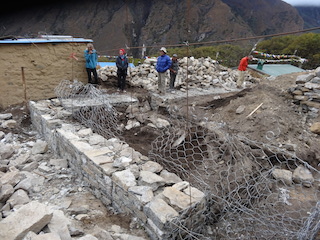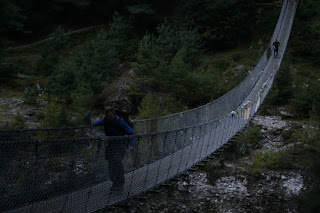We settled into our camp in Phortse then walked down to Mingma’s home site for our first real look at what we would be spending the next 9 days doing. Indeed, Mingma’s original home, half destroyed by the earth quake, had been taken down and sorted into various piles of salvaged materials. Check.
Nothing else Trevor and I had asked was done. Though we had harped endlessly for three months about having the gabions built and the lumber purchased neither were. There was no where near enough concrete mix and an even greater dearth of sand and gravel to mix with it. The twenty workers I had asked Mingma to select, and he had assured me were at the ready, turned out to be an earnest crew of six. A carpenter’s tent had been erected and work was well underway to build new Sherpa windows for the future home, in spite of the old salvaged windows appearing perfectly usable. We were stunned and crest-fallen.
When I asked Mingma about the 2x4’s we had listed on the supplies detail he smiled and said “Is not possible.” I told Mingma there would be very little we could accomplish without the materials we had asked him to obtain. Strangely, this did not seem to worry him much. So we stalked back to our camp shaking our heads and wondering where the hell things had all gone wrong.
The team drank Khukuri rum in our dining tent and tried to cypher the strange circumstance we had just travel half a world to get to. Central among our questions was the money I had sent to procure building materials. Back at the home site I had asked Mingma how much of $9,000 sent by Western Union was left. At first he said none. Then he said $1,000. I knew it had cost $2,600 to salvage his old home, but this till left about $5,000 unaccounted for. How could it be gone when there was nothing to show for it? We turned in early, tired from the trail, and resolved to figure the whole thing out the next day.
I woke that night around 2 a.m. and, lying in my tent, hit upon the only answer that made sense; Mingma had hired a Contractor to build his home instead of relying on us. That was why the money was gone. Mingma had handed it over to the contractor. There were no supplies because either the builder planned to use only salvaged materials, or he would be ordering supplies later as needed. Mingma had talked about a “carpenter” working on his home, but his limited english must have intended to say Contractor.
I ran my theory by the rest of the team at breakfast the next morning. Most thought it seemed plausible. I asked Dawa, our chief guide, to come with us to Mingma’s that morning as his english is quite good and, absent a vested interest, he seemed like the straightest path to the truth of the matter. He, Mingma, and I retired to Mingma’s makeshift home for a conference a short while later.
“I think I understood what you said yesterday,” I began through Dawa, “but I need to make sure so I asked Dawa to help me today.” Mingma nodded pleasantly. “You used part of the money I sent to have your old home salvaged and the rest you gave to the carpenter you have hired to build your new home.” Dawa translated. He and Mingma exchanged a few words, then both nodded to me in affirmation. It was important to phrase things this way, as though Mingma had already come forth with the most difficult piece of information, to avoid any loss of face. “And the carpenter will use that money to buy supplies and pay workers,” I continued. Again Mingma and Dawa both nodded agreement. “So we are here just for the idea of the house, to get it started and teach the drawings to the carpenter?” This too was correct. I didn’t feel any better, but at least I now understood.
Outside, Claus and Jess were busy making measurements and laying out the foundation lines for the new home. I told them what I had learned, then joined in helping with their survey. Having something to do helped us work off our frustration and by setting the corners for the new house we could at least make sure it would be situated, as planned, away from the downhill terrace. We broke for lunch at noon and hiked back to our camp.
While the cook’s assistant, Nuri, spooned out fried spam and potatoes, we all sorted through the smoldering remains of our fine fine plans. There was no doubt in my mind that Mingma, after months of communicating with Trevor (OSH Architect) and myself, understood our original plan. It also seemed clear he had chosen to change that plan without consulting us. This was troubling, but the question remained “what do we do now?” Since a professional crew (from Namche) had been hired, there would be no teaching opportunity for local Sherpa. There might be tools or techniques we could teach to the hired workers, but the notion of providing a trade to local Sherpa was out the window. On the other hand, this took the onus off of us to accomplish great things during the short time we were to be in Phortse since a competent group of builders would continue on until the home was built. And that was the main thing we set out to do; make sure a new home was built for Mingma. From that perspective it wasn’t particularly important who built it. But we also wanted to make sure the new home was earth quake resistant and our confidence had been rattled. It seemed likely this contractor and Mingma would err toward what they knew once we left, building the new home back in the same fashion of the one that had fallen down. That would not do.
Dawa and I met with Mingma and the contractor again after lunch. We went over the plan designs in great detail. I hammered hard on the parts that were critical to improved safety, like tying the home to the foundation with rebar, and they genuinely seemed committed to building the home designed by Trevor. So Jess, Claus, and I decided to work on the project as far as possible until absent materials brought things to a halt.

















































